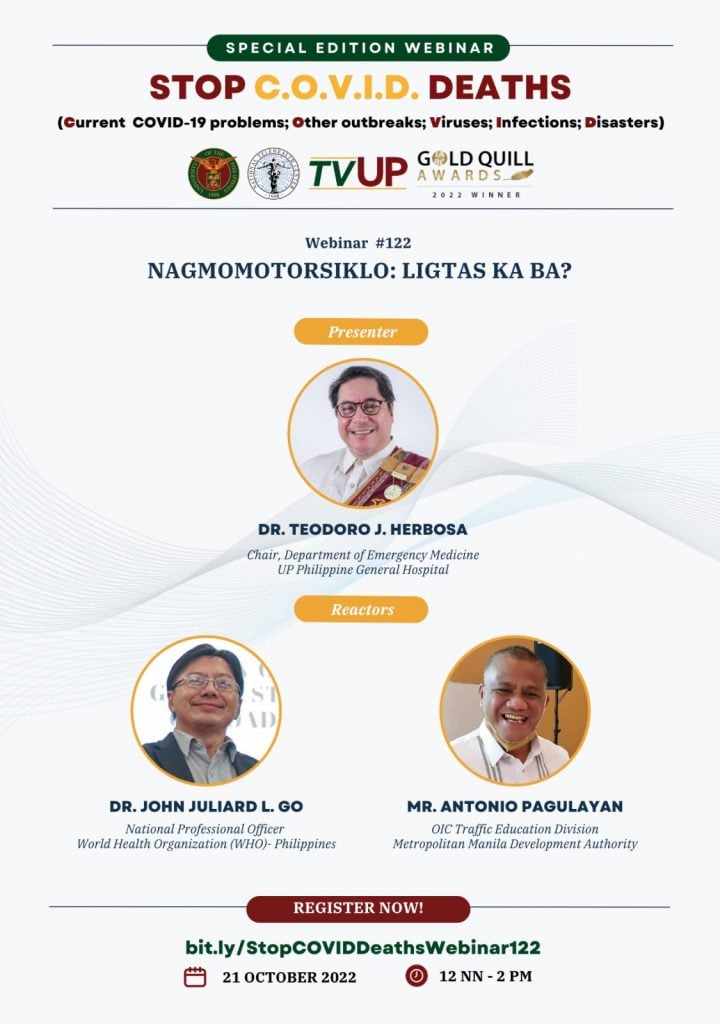
- This event has passed.
Stop COVID Deaths Webinar #122 “NAGMOMOTOR: LIGTAS KA BA?”

The University of the Philippines in partnership with
UP Manila NIH National Telehealth Center and in cooperation with
UP Philippine General Hospital
would like to invite you to join the Fight Against COVID-19!
Registration slots are limited to this SPECIAL EDITION of
the STOP C.O.V.I.D. DEATHS Webinar Series.
(Current COVID-19 problems; Other outbreaks; Viruses; Infections; Disasters)
So sign up NOW:
bit.ly/StopCOVIDDeathsWebinar122
Webinar #122
October 21, 2022 (Friday) 12nn
“NAGMOMOTOR: LIGTAS KA BA?”
Presenter:
Dr. Teodoro. J. Herbosa
Chair, Department of Emergency Medicine
UP Philippine General Hospital
Reactors:
Dr. John Juliard L. Go
National Professional Officer
World Health Organization- Philippines
Mr. Antonio Pagulayan
OIC Traffic Education Division
Metropolitan Manila Development Authority
Synthesis and Closing Remarks:
Dr. Dionne Sacdalan
PGH Coordinator for Training
UP Philippine General Hospital
———————————————————–
Webinar #122
October 21, 2022
“NAGMOMOTOR: LIGTAS KA BA?”
Driving through our major highways, or even on the smaller side streets, there are motorcycles everywhere: left, right, in front, behind. This phenomenon is true not only in the big cities but in the smaller cities as well. Our streets are crowded with motorcycles. Admittedly, it is a faster way to get around. With the skyrocketing prices of fuel, it is a solution for those who can no longer afford to drive their cars. But how safe are these two-wheelers?
WHO reports road traffic injuries are the leading cause of death for children and young adults aged 5-29 years. Approximately 1.3 million people die each year as a result of road traffic crashes. More than half of all road traffic deaths are among vulnerable road users: pedestrians, cyclists, and motorcyclists. Nearly 30% of all road crash deaths involve powered two- and three-wheeled vehicles, such as motorcycles, mopeds, scooters and electric bikes (e-bikes), and the numbers are rising.
On October 11, the World Health Organization and partners launched “Powered two-and three-wheeler safety: a road safety manual for decision-makers and practitioners” that includes guidelines on developing safer roads, ensuring safer mobility for all road users, vehicle safety standards and actions to improve emergency responses to crashes.
“Globally, key risk factors for motorcycle traffic injuries include drivers not wearing helmets, speeding, alcohol impairment, mixed traffic conditions, a lack of protection from the vehicle in a crash and a lack of safe infrastructure for powered two and three wheeled vehicles such as poor road surfaces and roadside hazards.”
How safe are motorcyclists in the Philippines? In this episode of STOP COVID DEATHS, trauma surgeon, Dr. Teodoro J. Herbosa, Chair of the Department of Emergency Medicine at the UP Philippine General Hospital, will share local data on motorcycle crashes based on reports from Philippine hospitals. He will discuss various injuries from two-wheeler crashes and recommendations to minimize risks for road traffic injuries. Dr. John Juliard L. Go, National Professional Officer of the World Health Organization (WHO)- Philippines, will talk about the work of WHO in supporting countries in making their roads safer, while Mr. Antonio Pagulayan, OIC of the Traffic Education Division of the Metropolitan Manila Development Authority (MMDA) will discuss challenges and solutions for road safety. The Synthesis and Closing Remarks will be delivered by PGH Coordinator for Training at UP Philippine General Hospital, Dr. Dionne Sacdalan.
Join us in this exciting episode of STOP COVID DEATHS, tackling road injuries – what we should know, what we can do and how we can help stop unnecessary deaths from unsafe roads. See you online! Together, we can STOP C.O.V.I.D. DEATHS!
